-
San Francisco International Film Festival 2008
San Francisco International Film Festival 2008

ASIA ARGENTO IN SFIFF
OPENING NIGHT FILM:
BREILLAT'S LAST MISTRESS
This introduces my coverage of the San Francisco International Film Festival, SFIFF/51, April 24-May 8, 2008.
Below is an index of all the SFIFF films I have seen with links to my reviews.
SFIFF titles I had seen and reviewed prior to the festival:
ALEXANDRA (ALEXEI SOKUROV)
ALL IS FORGIVEN (MIA HANSEN-LOVE)
BRICK LANE (SARAH GAVRON)
FADOS (CARLOS SAURA)
GIRL CUT IN TWO (CLAUDE CHABROL)
GO GO TALES (ABEL FERRARA)
IN THE CITY OF SYLVIA (JOSE LUIS GUERIN)
LAST MISTRESS (CATHERINE BREILLAT)
MAN FROM LONDON, THE (BELA TARR)
ROMANCE OF ASTREA AND CELADON, THE (ERIC ROHMER)
STILL LIFE (JIA ZHANG-KE)
STANDARD OPERATING PROCEDURE (EROLL MORRIS)
Films first seen at the SFIFF. My reviews of these are in the thread below:
ART OF NEGATIVE THINKING, THE (BARD BREIEN)
THE AQUARIUM (YOUSSRY NASRALLAH)
BALLAST (LANCE HAMMER)
BARCELONA (A MAP) (VENTURA PONS)
EZRA (NEWTON I. ADUAKA)
FRANCE, LA (SERGE BOZON)
FROZEN (SHIVAJHEE CHANDRABHUSAN)
LADY JANE (ROBERT GUEDIGUIAN)
LATENT ARGENTINA (FERNANDO E. SOLANAS)
MEDICINE FOR MELANCHOLY (BARRY JENKINS)
NOT BY CHANCE (PHILIPPE BARCINSKI)
ORZ BOYZ! (GILLIES YA-CHEE YANG)
RECYCLE (MAHMOUD AL MASSAD)
SHADOWS IN THE PALACE (KIM MEE-JEONG)
SECRET OF THE GRAIN, THE (ABDELLATIF KECHICHE)
SLEEP DEALER (ALEX RIVERA)
SOLITARY FRAGMENTS (JAIME ROSALES)
STRANDED: I CAME FROM A PLANE THAT CRASHED ON THE MOUNTAINS (GONZALO ARIJON)
STRAY GIRLFRIEND, A (ANA KATZ)
TIME TO DIE (DOROTA KEDZIERZOWSKA)
TRAVELING WITH PETS (VERA STORZHEVA)
TWO LADIES (PHILIPPE FAUCON)
UNDER THE BOMBS (PHILIPPE ARACTINGI)
UP THE YANGTZE (YUNG CHANG)
VALSE SENTIMENTALE (CONSTANTINA VOULGARIS)
VASERMIL (MUSHON SALMONA)
WATER LILIES (CELINE SCIAMMA)
WONDERFUL TOWN (ADITYA ASSARAT)
Each link above will take you directly to my review of the title.
For comments or discussion, the Filmleaf SFIFF 2008 forum thread is here.

GALINA VISHNEVSKAYA IN ALEXANDRA
Last edited by Chris Knipp; 07-07-2008 at 02:39 PM.
-
Robert guediguian: Lady jane (2008)
ROBERT GUEDIGUIAN: LADY JANE (2008)
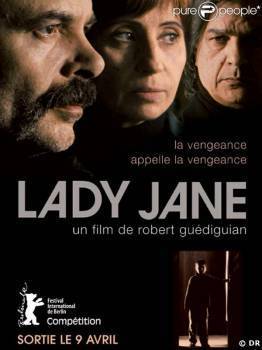
Depressed noir
Muriel (Ariane Ascarde), Francois (Jean-Pierre Daroussin) and René (Gérard Meylan) are a trio of longtime friends who grew up together in working-class Marseille. As the film begins, Muriel learns by cell phone that her teenage son Martin (Giuseppe Selimo) has been kidnapped. She calls on Francois and Rene to help her raise the ransom. Only later we learn that the three, Muriel included, share a criminal past and were the trio in old-men masks distributing stolen furs free to slum denizens in the pre-title opening sequence. Like some other scenes, this opener is a visual shock accompanied by loud noise, in this case electronic music. There's a shooting scene that makes the most hardened viewers jump.
The team split up years ago after one of them killed a jeweler in a parking garage. They've gone straight since, more or less. The need to raise lots of cash fast leads to new crime but not in coordination this time, and things go badly wrong again. Now that they're middle aged and bourgeois whatever idealism those free furs symbolized has faded into hopelessness and routine. Francois doesn't even love his pretty wife and daughters and wants to revive his old romance with Muriel, but no chance of that.
At present Muriel has a perfume business she runs out of a nice shop on a square in Aix. She calls it "Lady Jane," a nickname her father gave her from the Rolling Stones song. Francois runs a boating center some drug runners use. Rene has a strip club and rents out game machines to cafés. They're legit, but their straightness, especially in the case of Rene, is just this side of shady. The French call this kind of film a "policier;" but the only actual policeman we see is a young lieutenant (Pascal Cervo) who briefly asks a few questions and then disappears. Guediguian drenches the screen with images of the three principals' faces in emphatic closeup--especially Ascarde's grim, stony stare. He mouth remains a tight little line but sometimes a few tears drop down her cheeks. I'm guessing like the director she's of Armenian origin, and her stoical mug recalls the immortal deadpan of Charles Aznavour in Shoot the Piano Player. Hard to know what's behind it besides a diminishing enthusiasm for life. Only in the final scene do we find out this is a double revenge story, one that concludes with an old Armenian saying: "One who seeks revenge is like the fly that bangs repeatedly against a window, when there is a door that lies open." In Guediguian's rethinking, revenge is a dish that never tastes good, hot or cold.
Lady Jane opened in Paris under two weeks before its US debut at the San Francisco film festival. Some French reviewers said the burnt-out mood of the trio reflects disenchantment with the Sixties. If so, this is a somewhat heavy-handed way to convey it, and indeed while some elements of Lady Jane work very well, others don't. The symbolism and existential monologues slow things down, and the jagged and jarring use of flashbacks doesn't really succeed in linking past and present. The film's obvious strengths are Guediguian's rapport with his actors and the way he uses them and his rapid editing of boldly shaky sometimes amateurish feeling camera images to recast a crime thriller (with plenty of violent acts) in harsh naturalistic terms, dropping slickness in favor of vérité, so that you sympathize with these characters even as you deplore their destructive behavior. There are some odd twists that keep you curious about the action (even though it's slowed down too often), and some classic French noir trappings remain reassuringly present: the stolid expressions, shiny cars, nightclub scenes, a tense failed rendez-vous in a train station, and some effectively shot violence. But in dwelling on atmosphere Guediguian holds back on story details so long that he has to resort to a glib, hasty finale where explanations of motive and identity are spoon-fed to us at the last minute as in a slick mystery or a TV cop show. Still, if you have the stomach for it, this is good stuff, with US theatrical potential and a good reception in France.
Last edited by Chris Knipp; 08-08-2014 at 09:49 PM.
-
Yousry nasrallah: The aquarium (2008)
YOUSRY NASRALLAH: THE AQUARIUM (2008)
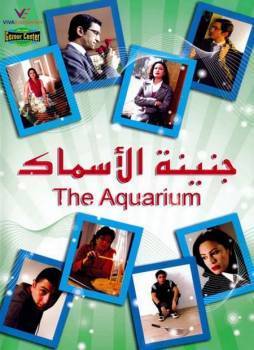
Night people, a teeming city, and camel's liver for breakfast
A man falls asleep in his car and wakes up to find twenty men in galabiyyas and a camel looking in the windows at him. This could only happen in Egypt. And why did he come here to wait till dawn? To have fresh sautéed camel's liver for breakfast. This is just one moment in The Aquarium's ambitious 48-hour ramble through Cairo focused on two detached observers of life, Youssef (Amr Waked) the camel's liver devotee and an anesthesiologist, and Leila (Hend Sabri), a late-night radio Miss Lonelyhearts who lives with her mother and sister. These two lost souls run into each other towards the end, but any storyline takes second place to the film's meandering examinations of this and that with an emphasis on Cairo life and its repressions, sexual and political.
Included is a woman (Samah Anwar), who would be glad to rent her apartment to Leila if the latter moves out on her own. She, like various others, addresses a monologue to the camera about her character, chiefly focused on the dangers of being a Christian woman living alone in a Muslim neighborhood. Leila's studio assistant Zaki does the same for his character; so does one of Youssef's young patients and Leila's married sister, who points out how detached Leila is, how unwilling to actually go out and help people who most need it. These monologues are an interesting way of opening up secret lives and they enrich the film's human panorama considerably. But of course they don't advance the action; they stop it.
Outside during the daytime, there's a big demonstration in the streets with placards calling for an end to all sorts of things, hunger and poverty for a start. Perhaps Leila's thoughts of an apartment and Youssef's homelessness (he won't move in with his divorced girlfriend and lives in his car rather than his own flat) are gestures toward Cairo housing problems; but unlike last year's Yacoubian Building (Marwan Hamed), The Aquarium barely glances at the urban poor and is mainly concerned with the better-off middle class. Going to a nightclub, Youssef winds up driving with a member of the secret police, who says it's natural--they're the only people you can't escape. Leila has to deal with state censorship of her program, in the person of a veiled lady who thinks a caller with AIDS should be reported.
As there is a lack of privacy in Cairo, there is an omnipresence of drama and life. Youssef and an older friend walk along the Nile Corniche and every piece of bridge has lovers, every car is a little theater whose scenes we see and hear snatches of. The ambient sounds, conversations, songs, radio news, are pungent and never-ending, and there's also a very creditable hip hop group that performs midway and at film's end, as well as an imaginary silent film in black and white in which Leila acts out a children's story she's thought up about a woman in love with a pigeon. Perhaps most awesome visually are simply some long shots of Cairo streets at the outset, teeming multitudes moving in all directions. But the camera's, and the filmmaker's, readiness to look at things leads to occasional stoppages. As Peter Scarlet wrote in a comment for the Tribeca festival, "Nasrallah shoots The Aquarium in long and glacial takes, imbuing the movie [at times] with a stillness that borders on the inert."
Both Leila and Youssef are night people. Her program, recorded earlier, is broadcast in the wee hours, when she may go out and party with her older boyfriend, or dance suggestively with the rap band. He visits his aged father, dying of cancer in a hospital. And as she listens to night secrets, he enjoys hearing the twilight zone mumblings of patients he's putting under. At night, he works a second job assisting a gynecologist who performs illegal abortions and sews up raped women so they can seem to still be virgins.
When Youssef calls Leila's talk show, as he inevitably does, he confesses to a recurrent fantasy of the "Garden of the Fish" (Genenat al asmak) an elaborate concrete garden and aquarium he fears if he once goes in, he may never leave. The symbolism, of the garden being a voyeur's paradise and of Cairo at the same time being a fishbowl, is a little obvious; this is a movie that oscillates between occasional poetry and self-conscious significance. It's true as some have said that Nasser Abdel-Rahmane's all-encompassing screenplay may have looked better on paper, and there may be too much telling and not enough showing. But the images and sound of The Aquarium are often pleasing, and the picture of contemporary Cairo is a rich and naturalistic one, despite the free indulgence in surrealism and self-reflexiveness. Hend Sabri is voluptuous and believable as a sweet but self-centered young woman. Amr Waked, however, comes across as rather a cold fish, and when he laughs, that fish becomes a shark. If this were Rome and the Sixties and Fellini were at the helm his part would go to Marcello Mastroianni, and the lonesome anesthesiologist would carry the sick soul of Europe. There is a Felliniesque quality about the proceedings at times.
The Aquarium, shown as part of the San Francisco International Film Festival, was presented at the Berlinale, got its North American premiere at Tribeca this week, and is also scheduled for festivals in Taormina and Abu Dhabi.
Last edited by Chris Knipp; 08-08-2014 at 09:48 PM.
-
Jaime rosales: Solitary fragments (2007)
JAIME ROSALES: SOLITARY FRAGMENTS (2007)
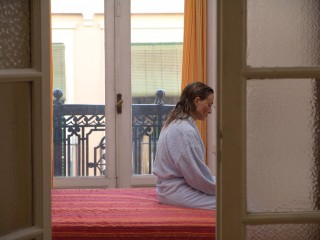
SONIA ALMARCHA
Scenes from life, a hymn to the quotidian
Rosales chooses to represent the everyday lives of two women in an everyday way. Short scenes, photographed with fixed cameras, sometimes in split screen; a focus on child rearing, an illness, mundane work (a grocery store, an office, a greeter for a convention), ironing clothes, playing cards, chatting about nothing much at dinner, or on a bus. A bus: ah, now there's some excitement. Young Adela (Sonia Almarcha), whose raising a one-year-old boy by herself and moves to Madrid, is on a bus that's blown up by a terrorist bomb. The next time we see her, she's battered-looking, and heads back to the country to see her aging papa. The mother of one of Adela's nice Madrid flat-mates, Ines (Miriam Correa), is Antonia (Petra Martinez), a widow who runs a grocery store, and the subject of the second story thread. Antonia's story is more complicated than Adela's, since she is closely involved also with two other daughters, Nieves (Nuria Mencia) and Helena (Maria Bazan). Nieves has to have an operation for cancer, and the self-centered Helena wants money so she and her husband can buy a second home. Pedro, Adela's ex, also wants to borrow money from her.
All this information is conveyed in the little vernacular scenes, with static cameras looking past objects, or several shots side by side on-screen showing the same people in a scene from different angles, and no music or much ambient sound--except that the last section is called "Background Noise.". It's like looking at a box of snapshots and piecing things together. Needless to say the actors are convincing. It's they who make this seem like eavesdropping on real conversations.
Money is tight, obviously. No one is doing especially well. The pressures lead Antonia to consider selling her house and moving in with her boyfriend Manolo (Jesus Cracio). Discussions over this cause a lot of tension within the family. Manolo repeatedly tries to calm things down, but without great effect. There are jealousies that must weigh on Antonia, and she is Nieves' chief support in her illness. Meanwhile Adela has to deal with trauma and loss.
Solitary Fragments won three Spanish Goyas, including Best Film and Best Director. It's everyday-ness and its reference to terrorism as a part of common experience may have impressed Spanish audiences especially, together with the dignity and restraint of the filmmaking technique. Rosales does a good job of balancing non-mainstream methods with humanistic content. Despite the distancing effects of the universally unmoving cameras, the alternating of two almost-unrelated story-lines, and a style that is low keyed to the extreme, one is drawn into the action through the eavesdropping, fly-on-the-wall viewpoint and one's ordinary curiosity about basic experiences and life choices. If this film doesn't awaken enthusiasm in everyone, it does command respect, and it builds gradually throughout its whole length with an increasingly profound sense of lives unfolding. The actual Spanish title is La Soledad, solitude, and subconsciously one is taught by the visual method, which never cuts back and forth in a conversation, for instance, to see each character as separate, essentially, in life, freestanding and alone.
Last edited by Chris Knipp; 05-18-2014 at 12:20 PM.
-
Ventura pons: Barcelona (a map) (2007)
VENTURA PONS: BARCELONA (A MAP) (2007)
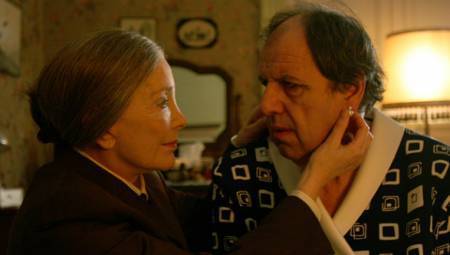
NURIA ESPERT, JOSEP MARIA POU
An old couple preparing to die
"People only really talk when they're about to die, and it's not usually very interesting," says Lola (Rosa Maria Sarda), an elegant French teacher and one of the tenants Ramon (Josep Maria Pou) asks to leave the rooms he's rented out to them for years. Lola expresses the assumption of this film, which focuses on Ramon and his wife as they review their lives and talk to the departing tenants. Ramon, who looks like Tom Wilkinson on a bad day, has cancer and hasn't long to live. The couple think they want to be alone for his last days. And yes, eventually they do really talk, and some of it isn't very interesting; but some is.
Pons has produced a provocative, well-acted little study, but it could as well be a play (it is adapted from one) and might have benefited from some more opening up. And this is true despite sepia illustrative clips that constantly interrupt the conversations. The director ought to have used these with more restraint. If somebody says "we once did such-and-such," she feels compelled to introduce a clip showing such-and-such being done--every time. Rather than liven things up, these sometimes frenetic and unnecessary two-second interruptions very often do little but emphasize the slowness of the main proceedings, and the drumbeats and loud clicks that introduce and conclude them become grating as time goes on. Unlike Bergman's Saraband, to which this has been compared, there is not much suspense in Barcelona (a Map) about what is going to happen. Conversations between landlords and tenants may not be the easiest way of delving deep into lives to begin with, and at first most of what emerges about Ramon and his wife Rose (Nuria Espert) indeed seem to be things they haven't, rather than have, done. This is true even when they talk to each other, and also when Rosa talks to her gay brother Santi (Jordi Bosch), about whom we learn only that he's a surgeon who cruises the baths.
However, Rosa and her little failed footballer and security guard David (Pablo Derqui), the second tenant conversation, do get kind of personal. Abandoned by his wife, David wants Rosa to be his mother. And he's naked when first seen and nearly naked during the interview. Pons seems to like showing naked men. And before the film is over, gender lines have been crossed and broken taboos have been revealed.
Ramon's smiles show he likes talking to the pregnant restaurant cook Violeta (Maria Botto, an actress from Argentina), who speaks Spanish (the rest is in Catalan). This is the third tenant conversation; and it turns out they actually have a surprisingly intimate relationship; this dialogue is even more personal, to the point of straining credulity. But nonetheless Violeta is the most alive person and the screen lights up with her presence and her beauty.
Of course the old couple have secrets--parenthood even he wasn't aware of in the case of Ramon, and a diary Rosa wants to reveal to Santi containing a revelation from their past. The final, most dramatic revelation, a gratuitous shocker, strains credulity even further and seems more like a desperate last-minute grasping for drama than anything that follows logically and organically from the material. (It's the kind of bombshell that works better on stage than on screen.) On top of that, as a denouement Ramon reveals to Rosa for the first time that he's a kind of male witch. With these attention-grabbers, what might have become a subtle study of old age is undercut by grotesque plot-line twists.
Pons is no amateur and the production though low keyed is stylish; the interiors are atmospheric; the cast is admirable. Nonetheless, the result is only for the patient and the credulous. The hothouse atmosphere gives you the feeling you get sitting indoors all day when it's nice outside.
Finally, in light of the overall theatricality, the basic premise begins to feel a bit dubious. It provides a pretext for long chats. But why should Ramon and Rosa be turning out these lodgers? How are they a bother? Isn't the rent needed? We learn in fact that when Ramon dies, Rosa will be forced to resort to trickery to collect her late husband's whole pension. Perhaps Ramon and Rosa should be talking to a geriatric counselor rather than trading last-minute revelations with each other and with departing lodgers.
Last edited by Chris Knipp; 08-26-2014 at 02:35 AM.
-
Kim mee-jeung: Shadows in the palace (20007)
KIM MEE-JEUNG: SHADOWS IN THE PALACE (2007)
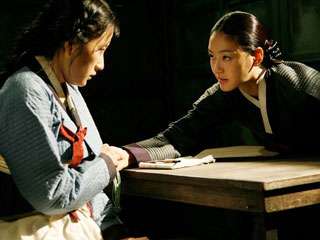
LIM JEONG-EON, PARK JIN-HIE
Period murder mystery marred by horror elements
A crime story and a lush costume drama about Joseon dynasty Korean court life are combined with horror elements in this directorial debut by South Korean Kim Mee-jeung. She was an assistant director for Lee Jun-ik's 2005 The King and the Clown and shot this on the same set. In Shadows,Wol Ryeong (Seo Yeong-hie) a maid-in-waiting at the palace, is found hanged. Chun-ryung (Park Jin Hee), the (female) royal doctor to the court women, investigates. Discovering the dead girl had a child of which there is no written record, she begins to suspect foul play. She questions a string of court ladies who might be implicated in a murder but nobody opens up and Chun-ryung's superior is obviously looking for a scapegoat to cover things up. This puts the doctor under the gun to find out what really happened before the scapegoat is named and everything is hushed up.
Throughout the film, the smooth workings of the Korean film-making machine are evident in lovely shots, nice but not grandiose settings and costumes, and an elegant period feel. The focus is far and away on women, and it's twenty minutes into the film before a single male appears.
Men are seen as attractive predators. Higher ranking women are agents of repression. The underlying issue is that court maidens are meant to be virgins, but court men are out to impregnate them. This is always the maiden's fault and punished by death if detected.
Both Shadows in the Palace and the previous The King and the Clown are dramas that use a period setting to bring up issues of court (i.e. government) repression. Shadows focuses on women and shows how they're treated cruelly in the palace, even by each other. In fact the focus on this is so strong--and there's a subplot of a concubine, Hee-bin (Yun Se-ah) who wants her son to be made crown prince--that intense interest is aroused in the sexual politics of the Korean court. The repressions of the supervising court maid (Sung-ryeong Kim) and her agents is shockingly brutal, and some of the torture scenes are hard to watch. She tries to pin everything on a court maid named Jung-ryul (Jeon Hye-jin), but it's obvious this cover-up is to protect a high ranking male. Meanwhile a court maid who's gone mute (Lim Jeong-eun) is terrified but nonetheless provides valuable evidence.
A review of the film on DVD two weeks ago on the website Twitch expressed what is probably the reaction of many. Shadows in the Palace, the Twitch writer (Mack) said, "is an attempt at the 'epic genre' that simply doesn't convince. Plot twists aside, when the real intentions behind the murderous plot are revealed you are neither surprised nor convinced, they are almost expected considering the context and content of the film." The reviewer was "more interested in the maiden court workings than. . .the horror/haunting elements. The physical and mental stress that came with positions in the court was more horrific than the ghost bits. They were stronger, more interesting and actually bloodier than their horror mashing counterpart." This is quite true. The socio-political themes work quite well with the mystery. The supernatural element may be logical as an outgrowth of the superstitions of the period, but it detracts from what was already a complicated enough story. Kim Mee-jeung shows talent in this handsomely put together film and the cast turns in good work. Maybe the director's focus on women's issues will find better and fuller expression next time.
Shown as part of the San Francisco International Film Festival, April 2009.
Last edited by Chris Knipp; 02-16-2012 at 06:57 PM.
-
Fernando e. Solanas: Latent argentina (2007)
FERNANDO E. SOLANAS: LATENT ARGENTINA (2007)

Solanas looks at the big picture for Argentina's future
Two years ago I very favorably reviewed the Argentinian documentarian Fernando E. Solanas' Dignity of the Nobodies, shown at the 2006 SFIFF. This new work by Solanas deals with exploitation of his country from outside and how Argentina can get out from under that and become a strong, rich, independent country. My heading for Dignity was "Chaotic and grainy, but for some of us, essential viewing." This one isn't so grainy, and it's still essential.
Solanas maintains a frankly socialistic, anti-neoliberal position. He focuses on resistance to privatization and points out that Argentina has enormous power that it has relinquished, but can reclaim. He beings simply with the great size and rich natural resources of the country. Then he works through a series of areas.
The aeronautical industry was established in the Thirties but completely disbanded in the 1990's, when the country's biggest family was turned over to Lockheed. The automotive industry got its energy in Argentina from the great enthusiasm for car racing in the Fifties, when the Argentinian driver Juan Manuel Fango was the Formula One champion. After producing economy cars, off-road vehicles, trucks, and tractors, again the country shut down factories to join Chile as a raw materials provider to the US and the multinationals. Solanas visits car factories in Argentina and talks to workers, where now only a few continue and much of the production is done by robotics manufactured in Japan. If only the robotics were at least manufactured in Argentina, one worker laments.
Some degree of recovery from all these concessions to the US and multinationals came after 2001 when local production became necessary to to a breakdown in monetary exchange. Solanas visits a factory as he did in Dignity which the workers themselves took over and began operating themselves on a more primative level when the owners went bankrupt and could no longer pay them wages. In a metals factory that now has huge orders from Johnson & Johnson, a socialist spirit reigns and decisions are made by consensus, not from the top down.
The scientific and industrial base of the country was most severely damaged because of the spread through Latin America of neoliberal policies, which reached its peak in the Nineties. This led to privatization and market-oriented training at the professional schools, and in turn to emigration of the best brains and talents.
Here Solanas visits a school in a poor area. The result of neoliberal policies is that the rich have 30 or 40 times richer than the poor instead of only 6 0r 7 as in the past. Still teachers perform a heroic effort to instill humanistic values in the young. The greatest enemies of progress and social equality, one teacher declares, are poverty and television.
Natural and especially mineral resources, Solanas points out, are still being turned over to the multinationals, despite a huge stock of available raw materials that Argentina has the potential and right to utilize locally and achieve more self sufficiency. And this is something that can come about, he says, through simply applying existing laws. One speaker says being self-sufficient requires first and foremost cheap energy--and so must begin with taking control of its oil.
Human resources are in effect being discarded by Argentina, Solanas shows, because the country isn't paying its specialists, technicians and scientists enough (one young local nuclear engineer, though he chooses to remain, says he makes $3 a hour); this is equivalent to simple expelling the best trained people from the country. Argentina has no national plan, a lady scientist says. It isn't financing scientific research. Researchers have the choice of leaving or working for multinational corporations that will have their best research done elsewhere. When ideas are originated at home, Argentina doesn't hold onto the patents. all this goes back to the fact that the nation has no vision for its future.
Consequently Argentina continues to follow a "colonialist" model, which in this context means behaving and thinking like a colony. Through the course of the film we see dozens of factories and research centers, nuclear reactors, fields of windmills, vast tracts of unexploited land--you name it. It's all there: not only the possibility of industrial growth, but already means of developing solar and wind power.
Solanas uses a wide angle lens throughout, which helps give a feeling of vastness. Even most interiors feel huge, whether of factories, offices, or classroom. One has a sense of room to grow, of wealth untapped, simply from the camera work. A nuclear scientist at a satellite center is enthusiastic about the creativity of the young people he works with. He says the country needs more interdisciplinary integration. Having come to Argentina from Italy at the age of nine, he is bursting with pride with what he describes as a "can-do" (se puede) nation. As an example, he cites what he worked on himself from his thirties: a uranium enrichment program that Argentina developed independently.
Once again, in the third film in his trilogy, "Pino" Solanas has given us a documentary full of enthusiasm and hope. Does he look much at disadvantages and obstacles? No. His aim is to inspire rather than deeply analyze. And he succeeds: his films have a tremendous drive and never lose their thrust or their focus.
Seen at the San Francisco International Film Festival 2008.
Last edited by Chris Knipp; 02-16-2012 at 07:33 PM.
-
Gonzalo arijon: Stranded i come from a plane...(2007
GONZALO ARIJON: STRANDED: I COME FROM A PLANE THAT CRASHED ON THE MOUNTAINS (2007)
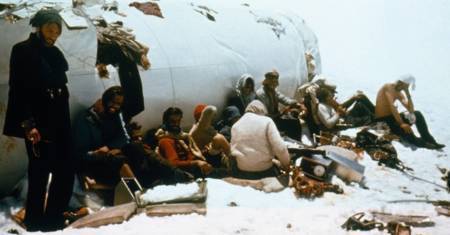
The ultimate survival story
In this excellent documentary survivors of the famous 1972 rugby team plane that crashed in the Andes tell their story with reenactments. This time, unlike the case of Errol Morris' new film about the Abu Ghraib scandal, Standard Operating Procedure, reenactments cause no discomfort, even though aspects of the events shown are famously chilling. That's because in this context, as with Kevin Macdonald's Touching the Void (coincidentally also about survivors in the Andes), participants in the events are present on-screen describing everything in detail so staged scenes don't feel like intrusion or speculation. There was a film dramatizing the events, Frank Marshall's 1993 Alive, with Ethan Hawke, Vincent Spano, and others, but this will be the definitive film statement on this event, one of the great survival stories of recent times. The grainy recreations blend seamlessly with the actual film footage shot of the survivors at the moment when they were rescued.
It was October. They were just going from their home town in Uraguay for a friendly rugby match in Chile, flying over the dramatic, snowy heights of the Andes mountains. And then it happened: the plane is in the middle of a snow storm with heavy winds, the pilot loses control, and they go down. The crash was quiet, soft, mysterious, some survivors report. The 24 who were still living were mostly fine. What logic, they ask, in their survival; the others' death? Marcelo, leader of the team, set a ration of one square of chocolate and a small cup of liquor a day.
An aerial search for the crashed plane was almost impossible because it was a year of exceptional storms, the reason the plane went down.
At first we see the men who survived talking about the trip, the mood, the flight, and the crash. And there are quick, often hazy reenactment shots. Later, some of the survivors are seen actually there in the recent present, revisiting the site, remembering the dizziness, weakness, and nausea of hunger, eating face cream, drinking deodorant cups of wine and feeling drunk--and all that followed.
And then one describes realizing as the days pass and they grow weaker what they'd have to do--"Either we do it, or die." It was a gradual consensus among them that they'd have to "take that step." They had entered a new world where a dead body could be a meal, as one puts it. It's with great subtlety and tact that the film leads up to this difficult subject. In the end, the viewer is spared nothing. It was a choice to live--a responsibility to parents and family to use any means necessary. It wasn't brute instinct but a debated, considered decision. And yet it was not unanimous, and ultimately remained "another unsolved problem." Some saw it as a kind of holy communion. And this is how, in an effective statement to the public, one of them stilled the sensationalism of the press later on.
The radio told them after thirteen days the air search was called off--a terrible blow. They knew then they had to get out on their own. This is where some made a heroic effort to climb up out of the basin where the plane lay.
Suddenly one night the others think they're dead when the plane gets buried by avalanche, so their refuge became a trap from which they had to dig out. In this event their team leader Marcelo died along with another person and they were all buried for three days. And the avalanches continued.
There were several expeditions, the big one by three, after more deaths, at 61 days. One returns, because he is not fit enough. The two "expeditionaries" on the eighth or ninth day come to a path where there's no snow, water, livestock. They see shepherds, and throw them a rock with a message about who they are. When they're taken back in a helicopter to rescue the others, it's unbelievable how far they walked. This return to the scene and the event 35 years later is perhaps the first time all the survivors could fully look these events in the face. It helps that these rugby players all came from the same school and still live close together. They're almost llike one big family. This is a very social experience all the way through--unlike many survivor stories, which tend to be lonely. But still, this is not the kind of thing many of us go through. There's a lot to ponder and digest here, and it's presented with the utmost skill and taste.
Seen at the San Francisco International Film Festival 2008.
Last edited by Chris Knipp; 08-26-2014 at 02:38 AM.
-
Philippe faucon: Two ladies (2008)
PHILIPPE FAUCON: TWO LADIES (2008)
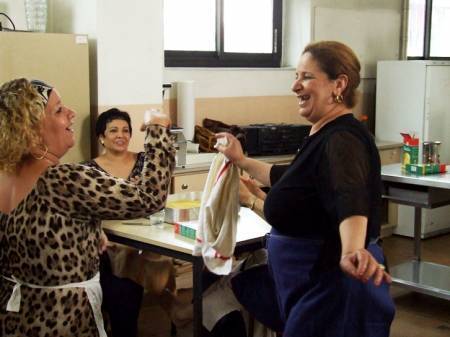
Two feisty ladies, one Arab, one Jew
Inbred prejudices meet unsuspected sympathies in Moroccan-born pied noir director Faucon's resonant, concentrated film. Selima (Sabrina Ben Abdallah) is an independent young nurse of Moroccan Arab origin in the south of France who gets a job doing care for a Moroccan-born Jewish woman, Esther (Ariane Jacquot), who's newly wheelchair-bound. Esther's complaints and abuse lead her housekeeper to quit, and Selima brings in her devoutly Muslim mom Halima (Zohra Mouffok) to clean and do kosher cooking. Problems ensue, but the "two ladies," both of considerable dignity, elegance and girth, find their commonality of generation, religiosity, and national origin overrides politics and prejudice. Halima and Esther hit it off and have many a giggle together. There's no doubt an element of wishful thinking in this story, which is simple in its telling but complex in its overtones; but this is trumped by the sheer authenticity of the people and the settings.
While the Variety reviewer likens this to an "after-school special," major French publications like Les Inrockuptibles, Cahiers du Cinema, and L'Humanité gave it a very high rating. Why this disparity? Perhaps because Americans don't see the need to acknowledge "little" things like Israel's devastating bombing assault on Lebanon two years ago (a event pointedly noted here) and aren't committed to living with a large muslim population?
Push comes to shove when Esther's doctor son, who usually looks after her, must leave town for a month for training and she agrees to spend the time in Halima's house. At first she kvetches, but before long she and Halima are having more fun together than ever. But mean gossipers in the neighborhood say Halima's earnings from the Jewish lady are tainted money and her plan to use them to make the Haj is "haraam," unlawful. She asks the imam after a mosque service (and this is a rare close-up of Muslim worship) and he gives the correct reply: the Koran says muslims and Jews are both "ahl ul-kitaab," People of the Book, they have had lawful dealings with each other since the Prophet's time, and if her employer has never objected to her religion or spoken ill of it, "you have been misled." There is nothing wrong in working for her, her money is "halaal," licit, for the pilgrimage. "Go in peace."
When Esther's son comes back early, she refuses to go home and insists on staying to see off Halima on her departure for Mecca. Again, authenticity prevails as the celebration of the Haj is shown.
Obviously Faucon, a Moroccan-born non-Arab like the character of Esther, knows whereof he speaks when it comes to Maghreban mulitculturalism, an issue pretty well known to French liberal intellectuals but remote from most Americans' ken. The freshness, vividness, and excellent production values make this a winner. We need more stuff like this. Serge Kaganski of Les Inrockuptibles wrote:* "A film that's simple and complex, ambitious and modest; that avoids no zone of conflict but explores them with calm, tact, and courage. From its paradoxes comes its beauty."
Two Ladies, whose French title is Dans la vie (In the Life) opened in Paris March 12, 2008, and was shown as part of the San Francisco International Film Festival, 2008.
*Link: http://www.lesinrocks.com/index.php?...ash=17a7bda148..
Last edited by Chris Knipp; 08-26-2014 at 01:55 AM.
-
Vera storozheva: Traveling with pets (2007)
VERA STOROZHEVA: TRAVELING WITH PETS (2007)

KSENIYA KUTEPOVA
Husband dies, wife is liberated
Young Natalia's unappealing husband, a railroad worker, keels over as a train passes by. He's dead, and her life begins. Storozheva's feminist portrait, not set in any clearcut time, feels slight but is beautifully shot and the young Kseniya Kutepova, who plays Natalia, has definite star quality.
Things initially are pale gray, in tune with Natalia's hitherto joyless life. She uses a railroad trolley to take her husband's body to the morgue and exchanges the family cow, a symbol of her servitude, for a white goat. Young Sergei (Dmitri Dyuzhev), an estranged husband with a spoiled young daughter, it turns out, gives Natalia a ride in his pickup and before long they're having a roll in the hay back at her place. When she's done and he won't go, she shows who's boss by pointing a shotgun at him.
The relationship is off and on for a while. Sergei is hunky and director Storozhova doesn't mind showing him off nude from all angles. He's one of those sensitive brutish types that pop up in Russian films. He's also highly sexed. That's fine with Natalia, who's never known sexual pleasure before, and she lets him back into her life and even gets friendly with his little daughter, despite the latter's annoying manner. But Sergei seals his doom when he says he wants to marry Natalia, get a cow, and turn her into a housewife. This is the limit of his mindset--and, apparently, of how Storozheva wants to represent men in the film.
Natalia is dreaming of other things. She has already gone around in a wedding dress just for fun, dressed up in rust and pink to set off her red hair, is immediately taken up by a group of train riders who stop over, and is hit on by the men. She goes on a brief ride, chased by her dog, then jumps off. Later she goes on a solitary ferris wheel ride and her radiant face symbolizes her impending liberation. Natalia has been compared to Tilda Swinton (she has her alabaster skin and auburn hair) but she also resembles the young Meryl Streep. This is a nice vehicle for her, and the film itself has won some festival prizes. Eventually Natalia takes a (symbolic?) boat ride to an orphanage (she was raised there herself, it seems) and adopts an enterprising boy of 10 or 12 with her coloring. In the final scene Natalia is returning homeward in her boat and the boy and her dog are falling in love with each other.
This seems a transparent and naive depiction of woman's liberation; what weakens it is the unspecific, fable-like setting and narrative. But teahnically it is flawless, the images lovely, keyboard music germane, and Ms. Kutepova a winner.
Shown at the San Francisco International Film Festival 2008
Last edited by Chris Knipp; 08-26-2014 at 01:57 AM.
-
Ana katz: A stray girlfriend (2007)
ANA KATZ: A STRAY GIRLFRIEND (2007)
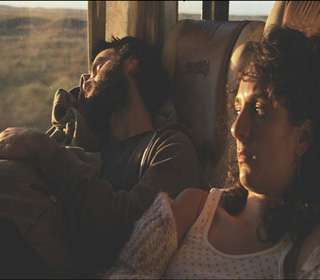
DANIEL HENDLER, ANA KATZ
Much ado about being dumped
Shown at Cannes last May, this film by the prolific thirty-something Argentine filmmaker stars herself in a semi-autobiographical film journal of the several days after Inez (Katz) is abruptly dumped by her boyfriend when embarking on a vacation in the woods. As her name suggests, the experience may be closer to that of screenplay co-author Ines Bortagaray. Katz does a very convincing acting job under the relentless scrutiny of a sometimes overly jiggly (and overly-close) hand-held camera that is on her and even in her face most of the time. The co-writer, director, and star bravely uses her own physicality in depicting the abandoned woman.
The narrative, and the camera, follow Inez' initial self-deception, tears and uncertainty, and gradual resignation to a situation over which she has no control. Absurdly, Inez gets off a bus where she has been constantly squabbling with her boyfriend Miguel (Daniel Hendler), and is puzzled when the bus pulls away with Miguel still on it. Inez finds she may have gotten off the bus a bit early since she has to walk some distance to get to the resort where they booked a room, so at first she figures that's why Miguel didn't step down. But Miguel was obviously fed up with Inez' neurotic neediness and no longer willing to talk. Miguel comes across as an inarticulate, cowardly creep; on the other hand, Inez is both self-absorbed and self-deluded. Inez goes ahead and checks into their double room at the inn and leaves messages for Miguel wondering what's happened. It takes her many hours to accept that Miguel is completely fed up with her--something evident to us in the first five minutes of the film.
Though this material, with its ridiculously unperceptive protagonist, could lend itself to the work of a female Woody Allen, Katz bypasses comedy in favor of a more naturalistic, almost real-time approach that at times strains the patience, though it does achieve a certain level of slice-of-life conviction. Perhaps the best accomplishment of the film is its evocation of the agonizing boredom of being in the wrong place at the wrong time--away from familiar surroundings, trying helplessly to "have fun"--when going through emotional pain. Unfortunately it's not entirely clear why exactly the audience needs to sit through all the hour-by-hour details of Inez' slow double-take, which aren't particularly memorable. Katz would have done well to muster a little more imagination in finding details. Her film shows the limits of an unmitigated diaristic approach. Just as Truman Capote said of Jack Kerouac's On the Road that it wasn't writing but typing, one might say of Una Novia Errante that it's not filmmaking but filming.
The one character who engages interest and momentarily keeps Inez busy is Germán (Carlos Portaluppi), a large, very chubby fellow who seems to live nearby. He too is the victim of a breakup--of his marriage, with kids--and appears adrift. He spends most of his time with other locals including a somewhat worse-for-wear looking woman who may cohabit with him in his disheveled abode, and he's a regular denizen of the resort's archery facilities and enjoys the occasional horse ride and dip in the ocean. Inez evidently feels he's getting too friendly, since when he's taking a swim, she hastily bolts. Later he attempts to steal a few kisses, but she'll have none of it. Meanwhile Miguel has answered his phone a couple of times. He's forced to talk back because Inez has been leaving endless messages and then begun deleting his emails. Once Inez' father (Arturo Goetz) and some others arrive unannounced, Inez seems to be getting back to normal, but there's not much sense of an ending.
Shown at the San Francisco International Film Festival 2008.
Last edited by Chris Knipp; 02-16-2012 at 07:27 PM.
-
Shivajee chandrabhushan: Frozen (2007)
SHIVAJEE CHANDRABHUSHAN: FROZEN (2007)
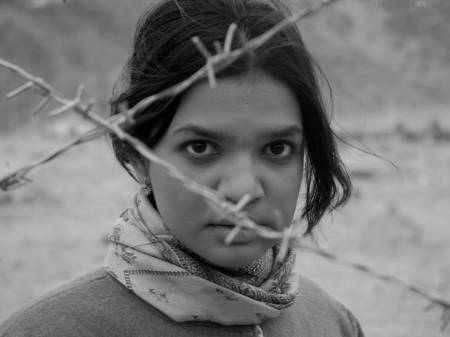
Weston and Friedlander collaged by Fellini
A stark black and white film about an odd little family living high in the Himalayas, this "first everything" effort (except for having a star who'd been in 149 films) is more memorable for its exotic, contrasty images than its somewhat detached portrait of marginal people.
Shivajee Chandrabhushan is a mountaineer. He actually chose to shoot this, his first film, in the rugged Indian region of Ladakh in the wintertime. Black and white was another choice to emphasize the relentlessness of the place and the difficulty of life for poor old Karma (Danny Denzongpa), whose karma doesn't seem too good. His only talent is for making apricot jam, in small quantities, on a hand-cranked machine which it strains his arms and back to work. When he takes this year's production to local customers he's too late and they've stocked up on manufactured commercial products. He's soon in deep financial trouble because a nasty moneylender, who leers at his pretty daughter Lasya (Gauri), is demanding a large payment. Lasya is a bit wild and crazy and has been kicked out of school. She mostly hangs out with her little brother Chomo (Angchuk), and they spar and chase each other around in a spirited manner that belies the harsh conditions of their life in the wind-torn old shack Karma regards as his ancestral home.
Lasya almost seems autistic. When she and Karma travel around the area, which includes a visit to a fair where there are clowns, Chandrabhushan is closer to the world of Fellini's La Strada than to either Bollywood or Apu.
Another threatening element in the environment is a military unit that moves into the surrounding area. The ranking officer gives Karma some sort of satellite phone system to use in case of trouble, and then later wants to requisition his house and relocate him. Eventually there will be no one left but Lasya, though at first this seems Chomo's tale, if only because of the presence of his voice-over narration. After various meanderings, there appears a young man with earrings called Romeo (Shakeel Khan), almost like a gypsy, who says he's in love with Lasya and madly chases her around.
This is a world of the imagination, however intense its seeming physicality, and the whole narrative shows a weak grasp of the actual that may be natural to high altitudes: everyone's a little light headed. What remains after the film ends are not events, not even specific images however rich these are in local color, but an impression of intense contrastiness and graininess, scatterings of dark rocks in big patches of snow. It's like an acid trip vision of some of the greatest work of twentieth-century black and white still photography, Edward Weston and Lee Friedlander collaged by Fellini.
Danny Denzongpa had played in over 150 films; all the rest were beginners, including the filmmakers. Chandrabhushan certainly shows great determination and independence of vision. But like his heroine Lasya, he seems a little erratic and emotionally remote.
Seen at eh San Francisco International Film Festival 2008.
Last edited by Chris Knipp; 08-26-2014 at 01:59 AM.
-
Dorota kedzierzawska: Time to die (2007)
DOROTA KEDZIERZAWSKA: TIME TO DIE (2007)
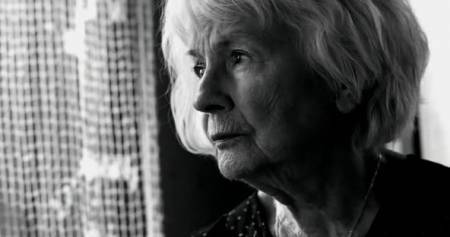
DANUTA SZAFLARSKA
A triumph in ripe old age
Aniela, played by remarkable Polish veteran stage and screen great Danuta Szaflarska, is as much a sprightly, unyielding relic of the past as the big dacha-style house surrounded by tall trees in which she lives alone with her impetuous dog, Philadelphia. Across the way, spied from a glassed-in porch through old opera glasses, she disapprovingly observes a boorish fat nouveau-riche man in a big new house, and over in a corner, a shabbier building occupied by a struggling music school, whose outdoor horn lessons she also deplores, talking to "Phila" in a running monologue.
The world is distorted, unfriendly, remote, but Aniela is lively, cheerful and defiant in the face of it all. Her first words on-screen (as rendered in the excellent subtitles), spoken to an impolite woman doctor she decides not to deal with, are "Kiss my ass."
Time to Die is an ironic title that suggests a dejection utterly foreign to this feisty and charming old lady. The film was largely conceived by Kedzierzawska as a perfect vehicle for her star Szaflarska, a tiny, indomitable woman who at 91 seems to skip up and down stairs and dance across rooms, her strong voice never faltering. (Seen at a festival screening at 93, she was equally sprightly.) But this is not just a vehicle for the star; the house, the dog, and the surrounding impingements are equally important--as is the camera, shooting in black and white; DP Artur Reinhart is another star whose work here dazzles and entrances. He makes much use of refracting lenses that convey at once a sense of the old windows of the house and of Aniela's own quirky vision, which can quickly shift to musings on the past. She not only sees her son (Krzysztof Globisz), now a big pasty-faced man with a peevish, fat little daughter (Patrycja Szewczyk), but a more idyllic image of that son as a handsome boy (Wit Kaczanowski Jr.) playing on the swing that still hangs from a big tree below.
Time to Die excels in many areas, not only in its extraordinary star, its gorgeous black and white images, and its rich sense of place, but in its ability to convey a sense of time savored minute by minute. Like many old people Aniela may not sleep much. Anyway she seems never to lose consciousness or even to stop talking to "Phila" or on the phone or to her son or to people outside. There's even a naughty urchin they call Dostoevsky (Kamil Bitau) because his first name's Fyodor, who's going to be studying drums at the music school but meanwhile climbs up to the second storey thinking to steal something. She's friendlier to him than to the rich boor from next door, who she sends packing, with Philadelphia snarling obediently after him. There are also nosy Kafkaesque city bureaucrats, and everybody wants Aniela's house or her land.
In time she finds out her own son's intentions are hardly as honorable as she'd assumed and she has to decide on some course of action. Is it "Time to Die"? No, not yet. But of course this is a kind of Endgame, and Aniela, cheerful and mobile though she is, still remains an Old Stancher in the Samuel Beckett sense, alone with her beautiful memories, out of touch and out of sorts with a new world of which she rarely approves and which is not very kindly toward her.
Though slight in content by some mainstream movie standards, Time to Die is a rich and beautiful experience. It was interesting to see it at the San Francisco film festival right after the equally striking black and white film Frozen (Shivajee Chandrabhushan). Kedzierzawska is working with material and with an actress she knows and the difference in emotional content was enormous. The cinematography also seemed to have more of a point to it since it so evocatively suggested a vision grounded firmly in the past but still alive in the present. Alive is the word, because the camera seems to breathe in this one. A long crane shot rising up beyond the roof and into the sky at the end is a wise move to give a sense of ascent and also perspective. The extraordinary Danuta Szaflarska agreed with the director at an after-screening discussion that this film was one of the best opportunities she's ever had in her long and successful career. Not having seen other work by Kedzierawska one can't comment but surely this must be one of her greatest successes. Incidentally, this is one of the best performances by a dog you're likely to see.
Seen at the San Francisco International Film Festival 2008.
Last edited by Chris Knipp; 08-26-2014 at 02:02 AM.
-
Mahmoud al massad: Recycle (2007)
MAHMOUD AL MASSAD: RECYCLE (2007)
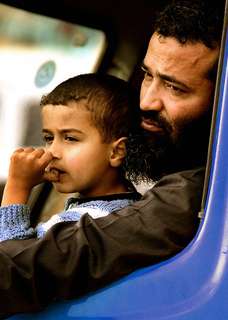
ABU BAKR AND ABU AMAR
In the land of Zarqawi, a man in search of completion
In this documentary that won a Sundance prize for its cinematography Mahmoud al Massad films ex-Mujahideen member Abu Amar, a bearded, devout Muslim man in traditional dress who is forced to survive by collecting cardboard boxes in his little blue truck with help of his sons and selling them to a recycling center. We're in a poor part of Jordan's second city, Zarqa, from which both filmmaker and his subject come. Abu Amar is rarely without his little son Abu Bakr, who even gets to take the wheel sitting in his lap. We don't meet the other sons or the several wives or other family members. In a Christian hospital we see his present wife just in one scene, momentarily unveiled for an interview about pregnancy. We often see friends, never identified, who discuss politics and economics. We also see that Abu Amar prays according to the requirements of Islam throughout the day, and goes to hear a fiery Friday sermon.
Early on Abu Amar and his friends talk about Abu Musab al-Zarqawi, the Al Qaida leader later killed by the US in Iraq. We see Abu Amar watching al-Zarqawi himself talking about Iraq on a TV station. Later Abu Amar watches Bush's announcement of the targeted killing on television. Al-Zarqawi came from the same neighborhood of Zarqa, but the locals agree he was an ordinary man, drove a bus, was a faceless city hall clerk, had little education, and wasn't even religious. They never even saw him at the mosque. "Who would think a man from this place would aggravate the whole world?" one says.
One thing they agree on is that jihad is something that it it is legitimate to turn to under certain circumstances. They express sympathy and understanding for those who organize to fight against the US occupiers, but they also insist that those who become "jihadis" do so only when government oppression or economic conditions or both have made them turn desperate. They also note, apropos of al-Zarqawi's apparent 180-degree shift, that turning to the mosque and the Koran sometimes is also the only help available in their country for a person fighting addiction to women, pills, or alcohol.
Abu Amar was in Afghanistan, but only as a security guard for Mujahideen leaders. He consequently laughs when asked by the director if he learned about their ideas through working with them.
When three Amman hotels are bombed on November 9, 2005 and Al-Qaida takes credit, Abu Amar is rounded up and held for four months as a suspect, then found innocent and released. He expresses gratitude for his release: justice was done, he says. He doesn't seem resentful.
Abu Amar traces all his current financial problems back to a major rift with his father--causes unspecified-- that forced them to close a commercial space where they were going to open a business. Abu Amar now only goes and lets himself in this space at night. There he has a typewriter and a plastic bag full of Islamic quotations. With the aid of these, he is working on a book which he can't get published. We see him typing away at it, and later reading to friends a passage arguing that it is wrong for Muslims to live in kaafir or "infidel" (non-Muslim) countries; that even converts to Islam should migrate to a Muslim country. This extremely narrow position appears ironic in the light of a step Abu Amar takes at the end of the film.
Whether by choice or by necessity, al Massad doesn't present a very complete picture of Abu Amar's milieu. It's perhaps because of the latter's strict Muslim principles that not much about his family is revealed beyond his close, if stern, interaction with his little boy. What we get to see is a man doing all he can to hold onto self-respect in a dead-end situation. His night typing on his manuscript seems done mainly to reassure himself that his former commitment and his informal religious studies have some value, rather than with the hope of his writings ever seeing the light of day. Even getting camel's milk for his sick mother is a frustrating, doggedly pursued process that takes repeated trips. Despite his expressions of faith and hope, his patience and his machismo, finally Abu Amar comes to seem a rather pathetic figure. Perhaps al Massad's portrait is all the more troubling and memorable for its very incompleteness. The man he is looking at is himself incomplete. The restrained portrait, which takes us up close without seeking to explain, is one whose implications are worth pondering.
Seen at the San Francisco International Film Festival, 2008.
Last edited by Chris Knipp; 03-18-2010 at 06:11 PM.
-
Philippe aractingi: Under the bombs (2008)
PHILIPPE ARACTINGI: UNDER THE BOMBS (2008)
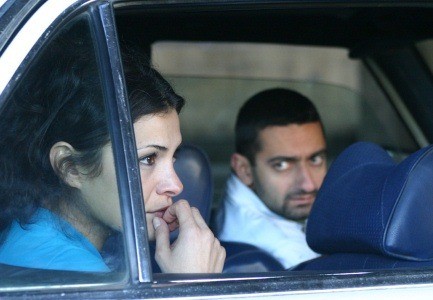
NADA ABOU FARHAT
Shooting in the shadow of war
Director Aractingi shot this film in the immediate wake of the systematic 34-day Israeli bombing of Lebanon in summer 2006, which left much of the country devastated, especially the South. He uses his own footage of the bombing itself, which shows whole neighborhoods being decimated, and then shoots among the rubble to tell the story of Zaina (Nada Abou Farhat), a divorced mother who comes from Dubai, where she was living with her architect husband, to find Karim, her six-year-old son, who was trapped by the bombing in Kherbet Salam, a Shia Muslim village in southern Lebanon. Zaina left Karim there with her sister, ironically, to "protect" him from the stress of her divorce. The only taxi driver who'll make the dangerous trip is Tony (George Khabbaz), a Christian who turns out to be from the South himself.
Aractingi got the idea of shooting in war devastation with an improvised plot in 1989 as Lebanon's civil war of that time wound down, but fear prevented him from proceeding. Instead he shot 40 documentaries and one feature that used improvisation (the 2005 Bosta) and also starred Nada Abou Farhat. As he got to work with his cast and crew for Under the Bombs, beginning shooting during the bombing and continuing during the ceasefire, he made the decision not to deal with the war so much as its impact on innocent victims, which Zaina and Karim obviously are.
And many of the people and their sufferings are authentic and real-time. When Tony and Zaina reach Kherbet Salam the building her sister lived in is completely destroyed. A young woman comes up and tells her Maha, her sister, is a martyr now. Zaina and Tony go to witness the disinterring of those who died to be reburied in "martyrs' graves," hoping to find the body of Maha (they do not). Aractingi films the actual funerals--not an easy task.
People say Karim was taken up by foreign journalists and went away with them, and this leads Tony and Zaina further south, just a few kilometers from the Israeli border, where they stop over with Tony's Christian family. It emerges that they were collaborators during the long Israeli occupation of south Lebanon and one brother is among those who fled to live in Israel in the aftermath of that time. The confrontation between Tony and his relatives over this collaboration is the fruit of discussions among villagers which Aractingi and his co-writer, Michel Léviant, condensed into a script. This is one example of how the actual fed into the fictional in the day-to-day shooting.
The emotions are powerful and the backgrounds are horrifying in the film. Nothing quite equals the sense of identification when Zaina looks at a whole street where her sister lived and finds only ruins after the systematic bombing destruction. Less successful at times are the interactions between Zaina and Tony, who flirts, comforts, and acts out a surprisingly graphic sex scene with a room clerk at a hotel they stop at on the way. Khabbaz and Abou Farhat are good, but some cutting might have helped eliminate distracting elements. The car's breaking down just before the couple gets to the monastery where Karim is rumored to be seems a rather obvious suspense device too.
The film is neutral as it can be, perhaps to a fault. One wonders why Hezbollah is barely even mentioned, since it is the other party in the warfare, and was the prime provider of aid to the victims in the bombing's immediate aftermath. Though the collaborating family members refer to being "forced to work for the Devil," meaning Israel, the focus is on the suffering rather than its source. Aractingi's film has flaws, but its boldness in bringing to the screen the 2006 bombing of Lebanon and the civilian suffering it caused can't be faulted.
The San Francisco International Film Festival 2008 provided the West Coast premiere of this film, which was scheduled to open less than two weeks later, on May 14, in Paris. This was nominated for the Grand Jury prize at Sundance and received the EIUC Award at Venice, as well as other festival awards.
Last edited by Chris Knipp; 08-26-2014 at 02:03 AM.
 Posting Permissions
Posting Permissions
- You may not post new threads
- You may not post replies
- You may not post attachments
- You may not edit your posts
-
Forum Rules






 Reply With Quote
Reply With Quote














Bookmarks